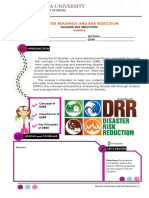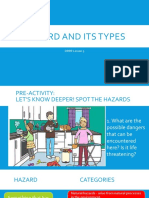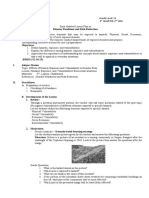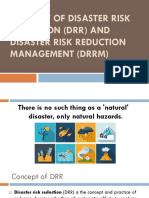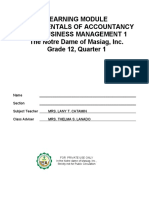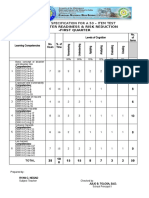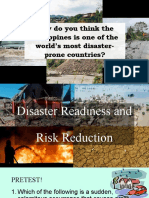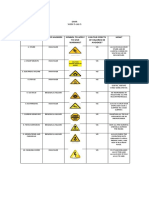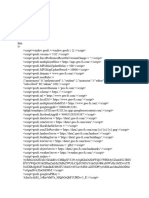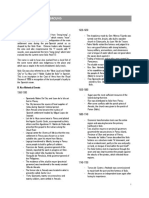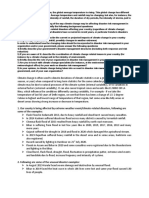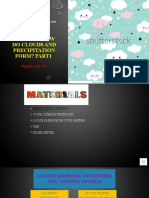DRRR
DRRR
Uploaded by
Joyce Dela Rama JulianoCopyright:
Available Formats
DRRR
DRRR
Uploaded by
Joyce Dela Rama JulianoCopyright
Available Formats
Share this document
Did you find this document useful?
Is this content inappropriate?
Copyright:
Available Formats
DRRR
DRRR
Uploaded by
Joyce Dela Rama JulianoCopyright:
Available Formats
DAILY LEARNING ACTIVITY SHEET
ACT.1-WEEK 5
Name: _______________________________________________ Score: __________________
Year & Section: ___________________ Day & Date Accomplished: __________________
Subject: Disaster Readiness and Risk Reduction Parent/ Guardian Signature: _________________
Activity Title: Hazards (Hazard Web)
Learning Targets: Understand the meaning of Hazards.
References Title: Deguzman, F.R., et, al. (2016) Disaster Readiness and Risk Reduction. Vibal Group
Inc. G. Araneta Avenue., Quezon City.
Author: Deguzman, F.R., et, al. (2016) Page No.:24-25
Main Idea
A hazard is defined as a potentially-damaging physical event that may cause the loss of life or injury, property
damage, social and economic disruptions, or environmental degradation.
Example/s:
The Philippines is exposed to hazards due to the presence of several factors: the Pacific Ring of Fire for Volcanic
eruptions, active fault lines for earthquakes, trenches for tsunamis, and the Pacific Ocean for tropical cyclones.
Typhoons, which occur in the country at an average of 22 times a year, also enhance the southwest monsoon
(habagat) which increases the possibility of storm surges.
Hazards know no politics, race, or creed; it could strike anytime.
With the changes brought about by the effects of climate change, hazards have become even more powerful and their
occurrences more frequent.
Activity/Exercises:
Directions: Read and analyze the meaning of Hazards. Give words associated with the word HAZARD. (10 points)
HAZARD
DAILY LEARNING ACTIVITY SHEET
ACT.2-WEEK 5
Name: _______________________________________________ Score: __________________
Year & Section: ___________________ Day & Date Accomplished: __________________
Subject: Disaster Readiness and Risk Reduction Parent/ Guardian Signature: _________________
Activity Title: Classification of Hazard (Arrange ME!)
Learning Targets: Classify the example of types of hazards.
References Title: Deguzman, F.R., et, al. (2016) Disaster Readiness and Risk Reduction. Vibal Group
Inc. G. Araneta Avenue., Quezon City.
Author: Deguzman, F.R., et, al. (2016) Page No.:25
Main Idea
Hazards are generally classified as natural or human-induced.
Natural Human-Induced
1. Geologic hazards- occur on Earth’s crust. 1. Biological Hazards- refer to threat from viruses or bacteria,
These hazards pose a threat to life and property. medical waste, microbiological samples, or toxic chemicals of
2. Hydrometeorological hazards- could be biological origin that can cause harm to human life.
atmospheric, hydrological, or oceanographic in 2. Technological hazards- can be industrial in origin. They may
nature. They could potentially cause loss of life be results from accidents, collapsed structures, and explosions in
and damage to property, and disrupt normal living the industries.
conditions and provision for services. 3. Socio-natural hazards-are the result of the interaction of a
natural hazard with overexploited land or other environmental
resources.
Example/s:
Natural Human-Induced
1. Geologic hazards 1. Biological Hazards
Earthquakes Epidemic diseases caused by viral and bacterial infection.
2. Technological hazards
2. Hydrometeorological hazards- Accidental release of chemicals, toxic and pesticides to flora
Typhoons and fauna.
Thunderstorms 3. Socio-natural hazards
Landslides
Floods
Activity/Exercises:
Directions: Choose the right example of types of hazards below and write it on the corresponding table.
Geologic hazards Hydrometeorological Biological Hazards Technological Socio-natural
hazards hazards hazards
Tsunami Fire Floods
Landslides Typhoons Tornadoes
Earthquakes Industrial explosions Transport accidents
Heavy snowfalls Epidemic in animals Epidemic in humans
Epidemic in plants Volcanic Eruptions collapse of public and buildings
You might also like
- Virginia Evans - Prime Time 4 - Student - S BookDocument205 pagesVirginia Evans - Prime Time 4 - Student - S BookSandro Gigauri78% (9)
- Diagnostic Test in UcspDocument3 pagesDiagnostic Test in UcspJoyce Dela Rama Juliano100% (11)
- IMST IMPORTANT QuestionsDocument2 pagesIMST IMPORTANT QuestionsJyoshna IllapuNo ratings yet
- Daily Learning Activity Sheet: Understanding Culture, Society and Politics Quarter 1 Week 1Document16 pagesDaily Learning Activity Sheet: Understanding Culture, Society and Politics Quarter 1 Week 1Joyce Dela Rama Juliano100% (2)
- Daily Learning Activity Sheet: Introduction To Philosophy Quarter 1 Week 1Document18 pagesDaily Learning Activity Sheet: Introduction To Philosophy Quarter 1 Week 1Joyce Dela Rama Juliano100% (3)
- DRRR - Grade 11/12: I. Introductory ConceptDocument10 pagesDRRR - Grade 11/12: I. Introductory ConceptCK BernalNo ratings yet
- Disaster Readiness and Risk ReductionDocument15 pagesDisaster Readiness and Risk ReductionDiane CezarNo ratings yet
- DRRR Midterms ReviewerDocument16 pagesDRRR Midterms ReviewerHans Matthew AntiojoNo ratings yet
- DRR and RF For StudentsDocument43 pagesDRR and RF For StudentsJasmineeissNo ratings yet
- Q4 LESSON 4 (Disaster Risk Reduction)Document8 pagesQ4 LESSON 4 (Disaster Risk Reduction)WhySoSerious?No ratings yet
- DRRR Q1 W1 - Mod1Document19 pagesDRRR Q1 W1 - Mod1Julie Ann BautistaNo ratings yet
- Q3 DRRR L5-Hazard and Its TypesDocument18 pagesQ3 DRRR L5-Hazard and Its TypesRuel PerezNo ratings yet
- First Quarter: (DRRM)Document14 pagesFirst Quarter: (DRRM)Yngrid Bless Z. CadenaNo ratings yet
- DRRR Reviewer 3rd QuarterDocument8 pagesDRRR Reviewer 3rd QuarterApril Joy T. GrijaldoNo ratings yet
- DRRRDocument26 pagesDRRRJemimah FV100% (1)
- 11 Disaster Readines and Risk ReductionDocument2 pages11 Disaster Readines and Risk ReductionDonaLd 쥍킿쨨곽No ratings yet
- Ucsp Tos Monthly ExamDocument8 pagesUcsp Tos Monthly ExamJuvelyn AbuganNo ratings yet
- UCSP NotesDocument4 pagesUCSP NotesRandolph Aj Ballesteros UgaddanNo ratings yet
- Curriculum Map (DRRR)Document8 pagesCurriculum Map (DRRR)Juvilyn FelipeNo ratings yet
- Key Concepts of Disaster, Hazard, Vulnerability, and CapacityDocument4 pagesKey Concepts of Disaster, Hazard, Vulnerability, and CapacityVijanes BeltransNo ratings yet
- DRR11 12 Ia B 5Document2 pagesDRR11 12 Ia B 5Jude TanNo ratings yet
- DRRR Unit 4 Lesson 4 5Document14 pagesDRRR Unit 4 Lesson 4 5JASMINE LAURONNo ratings yet
- GROUP 1: DRR11/12-1a-b-6Document3 pagesGROUP 1: DRR11/12-1a-b-6ben leeNo ratings yet
- Department of Education: Module in Disaster Readiness and Risk Reduction Grade 12 First Quarter Week 3Document2 pagesDepartment of Education: Module in Disaster Readiness and Risk Reduction Grade 12 First Quarter Week 3Chimmy Changa100% (1)
- Budget of Work: Teacher: Subject: Strand/Track: SemesterDocument4 pagesBudget of Work: Teacher: Subject: Strand/Track: SemesterkydgecruzNo ratings yet
- Sim DRRM Melc Q1 Week 3 L6 8 - 32 1Document32 pagesSim DRRM Melc Q1 Week 3 L6 8 - 32 1Chief DalpoNo ratings yet
- DRRR Module 8 SDLPDocument6 pagesDRRR Module 8 SDLPAr-Jay NabongNo ratings yet
- DRRR Reviewer 2NDDocument25 pagesDRRR Reviewer 2NDMaria Elaine S. QuinalayoNo ratings yet
- DRRR Chapter 1Document17 pagesDRRR Chapter 1Mariel VillaNo ratings yet
- UCSP FinalDocument8 pagesUCSP FinalAyesha Riz DemunaNo ratings yet
- Intro To DRRDocument165 pagesIntro To DRRLouray JeanNo ratings yet
- DRRRDocument12 pagesDRRRKathleen BrazasNo ratings yet
- VulnerabilityDocument19 pagesVulnerabilitymaddoxNo ratings yet
- DRR Quarter 4 Week 3Document4 pagesDRR Quarter 4 Week 3Shastine ClaorNo ratings yet
- DRRR Handout Volcanic HazardDocument4 pagesDRRR Handout Volcanic HazardAnonymous fKViHeaw0% (1)
- Session 6 SlidesDocument18 pagesSession 6 SlidesShekaina Faith Cuizon LozadaNo ratings yet
- Understanding Culture, Society, and Politics (UCSP) - GRADE 12Document2 pagesUnderstanding Culture, Society, and Politics (UCSP) - GRADE 12Jarven SaguinNo ratings yet
- Week 6Document5 pagesWeek 6Adrienne HernandoNo ratings yet
- DRRR Learning Module 2nd QuarterDocument58 pagesDRRR Learning Module 2nd QuarterLANY T. CATAMINNo ratings yet
- Name: - Score: - Year and Section: - DateDocument2 pagesName: - Score: - Year and Section: - DateEmerson Mercado GalanoNo ratings yet
- NAME: - COURSE/SECTION: - SCORE: Long Quiz in DRRRDocument3 pagesNAME: - COURSE/SECTION: - SCORE: Long Quiz in DRRRRenz GaraisNo ratings yet
- DRR11 12 Ih I 25Document3 pagesDRR11 12 Ih I 25Jude TanNo ratings yet
- On Disaster Readiness & Risk Reduction - First Quarter: Table of Specification For A 50 - Item TestDocument4 pagesOn Disaster Readiness & Risk Reduction - First Quarter: Table of Specification For A 50 - Item TestLiezel CauilanNo ratings yet
- Apply Mitigation Strategies (DRRR)Document40 pagesApply Mitigation Strategies (DRRR)Randel Nel JunianNo ratings yet
- Ucsp Q4 W1Document5 pagesUcsp Q4 W1Lemuel DoñaNo ratings yet
- Detailed Lesson Plan For DRRR April 08, 2022Document5 pagesDetailed Lesson Plan For DRRR April 08, 2022allan torreonNo ratings yet
- Lesson 3 Basic Concept of HazardDocument37 pagesLesson 3 Basic Concept of HazardNikki San Gabriel100% (1)
- Graphic Organizers For DRRRDocument7 pagesGraphic Organizers For DRRRKate Bandohan100% (1)
- DLP DRRR 1st QTR Week 1Document7 pagesDLP DRRR 1st QTR Week 1Rachelle Dulce Mojica-NazarenoNo ratings yet
- Disaster Readiness and Risk Reduction: Knock On WoodDocument12 pagesDisaster Readiness and Risk Reduction: Knock On WoodMaria FatimaNo ratings yet
- Week 5Document4 pagesWeek 5Adrienne HernandoNo ratings yet
- Chapter 1 Basic Concepts of Disaster and Disaster RiskDocument35 pagesChapter 1 Basic Concepts of Disaster and Disaster RiskJacinthe Angelou D. PeñalosaNo ratings yet
- 4th Prelim 2020Document14 pages4th Prelim 2020Mira VeranoNo ratings yet
- Midterm Assessment For 3RD Quarter2Document4 pagesMidterm Assessment For 3RD Quarter2Erumi ShidouNo ratings yet
- Activity 1 Hazard Found Type of Hazards Symbol To Apply To Give Warning? Can The Effects of Hazards Be Avoided? How?Document2 pagesActivity 1 Hazard Found Type of Hazards Symbol To Apply To Give Warning? Can The Effects of Hazards Be Avoided? How?Christian BenedictoNo ratings yet
- DLL Jeclyn DaissDocument5 pagesDLL Jeclyn DaissJeclyn D. FilipinasNo ratings yet
- DRRR Module 1Document69 pagesDRRR Module 1Joveliezel Jaducana Baroro RodriguezNo ratings yet
- TOS - UCSP - 3rd QuarterDocument1 pageTOS - UCSP - 3rd QuarterLORENZO RAMIREZNo ratings yet
- DRRR Reviewer 2nd Semester 1st Term PDFDocument2 pagesDRRR Reviewer 2nd Semester 1st Term PDF氷山匕尺100% (1)
- Pre-Post Test UcspDocument3 pagesPre-Post Test UcspAnnalie Delera CeladiñaNo ratings yet
- DLL DRRR Quarter 1 Week 5Document5 pagesDLL DRRR Quarter 1 Week 5Maria Lourdes PunayNo ratings yet
- Disaster Readiness and Risk ReductionDocument6 pagesDisaster Readiness and Risk ReductionAna Mariel VillocinoNo ratings yet
- DRRR Lesson1Document57 pagesDRRR Lesson1Teacher Anne ApolinarioNo ratings yet
- 4 Concept of Hazard and Types of HazardDocument6 pages4 Concept of Hazard and Types of HazardSenior High SJCSINo ratings yet
- Week 2 Act 2Document1 pageWeek 2 Act 2Joyce Dela Rama JulianoNo ratings yet
- Week 3 Act 1Document1 pageWeek 3 Act 1Joyce Dela Rama JulianoNo ratings yet
- Week 2 Act 1Document1 pageWeek 2 Act 1Joyce Dela Rama JulianoNo ratings yet
- 3Q (WEEK 6 ACT 1) Classification of SoupDocument1 page3Q (WEEK 6 ACT 1) Classification of SoupJoyce Dela Rama Juliano100% (1)
- Week 1 Act 2Document1 pageWeek 1 Act 2Joyce Dela Rama Juliano100% (2)
- Dla Quarter 3 Week 1 Act 1Document2 pagesDla Quarter 3 Week 1 Act 1Joyce Dela Rama JulianoNo ratings yet
- 3Q (WEEK 3 ACT 1) Proper Handling of SeafoodsDocument1 page3Q (WEEK 3 ACT 1) Proper Handling of SeafoodsJoyce Dela Rama JulianoNo ratings yet
- 3Q (WEEK 2 ACT 2) Principles of Cooking FishDocument1 page3Q (WEEK 2 ACT 2) Principles of Cooking FishJoyce Dela Rama Juliano100% (1)
- 3Q (Week 4 Act 1) StocksDocument1 page3Q (Week 4 Act 1) StocksJoyce Dela Rama JulianoNo ratings yet
- 3Q (WEEK 2 ACT 2) Principles of Cooking FishDocument1 page3Q (WEEK 2 ACT 2) Principles of Cooking FishJoyce Dela Rama Juliano100% (1)
- 3Q (WEEK 1 ACT 1) Classification of SeafoodsDocument1 page3Q (WEEK 1 ACT 1) Classification of SeafoodsJoyce Dela Rama Juliano100% (1)
- Daily Learning Activity Sheet Computer 7 4TH WeekDocument2 pagesDaily Learning Activity Sheet Computer 7 4TH WeekJoyce Dela Rama Juliano100% (1)
- 3Q (WEEK 6 ACT 2) Principles in Preparing SoupDocument1 page3Q (WEEK 6 ACT 2) Principles in Preparing SoupJoyce Dela Rama JulianoNo ratings yet
- Dynamic Learning Program Computer 7 1ST To 8TH WeekDocument2 pagesDynamic Learning Program Computer 7 1ST To 8TH WeekJoyce Dela Rama JulianoNo ratings yet
- Brief History of PhilosophyDocument21 pagesBrief History of PhilosophyJoyce Dela Rama JulianoNo ratings yet
- Health 6 DlaDocument4 pagesHealth 6 DlaJoyce Dela Rama JulianoNo ratings yet
- DLA TLE 8 Week 6Document2 pagesDLA TLE 8 Week 6Joyce Dela Rama JulianoNo ratings yet
- Dynamic Learning Program Jericho Q. Malto: SY 2020-2021 Health 5Document1 pageDynamic Learning Program Jericho Q. Malto: SY 2020-2021 Health 5Joyce Dela Rama JulianoNo ratings yet
- GeoFS SOURCE CODEDocument53 pagesGeoFS SOURCE CODEthucquyen86No ratings yet
- Coding Decoding - 2Document2 pagesCoding Decoding - 2rishikashrivastav0203No ratings yet
- Soal Pat B. Inggris Kelas 4 2022-2023Document6 pagesSoal Pat B. Inggris Kelas 4 2022-2023Bernadetha SetianingrumNo ratings yet
- Evaluation of The Socio-Economic Impact of Climate Change in Belgium (2020)Document253 pagesEvaluation of The Socio-Economic Impact of Climate Change in Belgium (2020)Climate Change Belgium100% (1)
- News ItemsDocument9 pagesNews Itemsalicia.ayubi01No ratings yet
- Socio Economic Profile. 2014 PDFDocument149 pagesSocio Economic Profile. 2014 PDFMyra QuidatoNo ratings yet
- Au Gui 0102Document69 pagesAu Gui 0102gomisuch1No ratings yet
- Cloud ChartDocument2 pagesCloud Chartaitormr100% (1)
- Project 2024-25 (IX)Document4 pagesProject 2024-25 (IX)vk8595348No ratings yet
- Gust Factor Calculation-GX and GYDocument16 pagesGust Factor Calculation-GX and GYPradnyaaNo ratings yet
- Weather AppDocument10 pagesWeather AppMohammed100% (1)
- Reyes RRL Me-ElectiveDocument5 pagesReyes RRL Me-ElectiveMarc GajudoNo ratings yet
- Our County Is Being Affected by Extreme Weather Event/climate-Related Disasters, Following Are Some of The ExamplesDocument4 pagesOur County Is Being Affected by Extreme Weather Event/climate-Related Disasters, Following Are Some of The ExamplesshreyanshNo ratings yet
- Weather AdjectivesDocument4 pagesWeather AdjectivesRINNY SEAH KWEE JEAN MoeNo ratings yet
- GE 4 EoU7 TestDocument4 pagesGE 4 EoU7 TestHồng NhungNo ratings yet
- Precipitation: Lecture Note Civil Engineering1Document28 pagesPrecipitation: Lecture Note Civil Engineering1Naif AbdulfetahNo ratings yet
- Lesson 4: How Do Clouds and Precipitation Form? Part1: PAGES 224-229Document23 pagesLesson 4: How Do Clouds and Precipitation Form? Part1: PAGES 224-229SaraNo ratings yet
- Climate Change Draft 2Document39 pagesClimate Change Draft 2Tanvir IslamNo ratings yet
- Unit 2 - Climate ChangesDocument5 pagesUnit 2 - Climate Changesana fonsecaNo ratings yet
- Edinburgh Crib Sheet 2101Document2 pagesEdinburgh Crib Sheet 2101bob johnsomNo ratings yet
- Final Test: Circle The Correct Answers. / 5Document4 pagesFinal Test: Circle The Correct Answers. / 5XeniaNo ratings yet
- Small Talk Conversation StartersDocument1 pageSmall Talk Conversation StartersZuzka ZatorskaNo ratings yet
- SS Test 1 Class 4Document2 pagesSS Test 1 Class 4smartservices2k2No ratings yet
- Class 8 Unit 8 LP - LIPDocument7 pagesClass 8 Unit 8 LP - LIPYepuri KrupanandamNo ratings yet
- Experiment No. 04Document3 pagesExperiment No. 04madhavkhandelwal848No ratings yet
- Chemistry Worksheet 13.1 - Gas LawsDocument3 pagesChemistry Worksheet 13.1 - Gas LawsJooa LeeNo ratings yet
- 02 - Unit 3 - Modals Worksheet May-MightDocument3 pages02 - Unit 3 - Modals Worksheet May-MightsantijimdomNo ratings yet
- Hurricane Miriam Tropical Storm JoanDocument8 pagesHurricane Miriam Tropical Storm JoanSana MerNo ratings yet
- 193137-Icewind Dale Travel Cheatsheet (Variant Rules)Document1 page193137-Icewind Dale Travel Cheatsheet (Variant Rules)Jesse HullNo ratings yet









